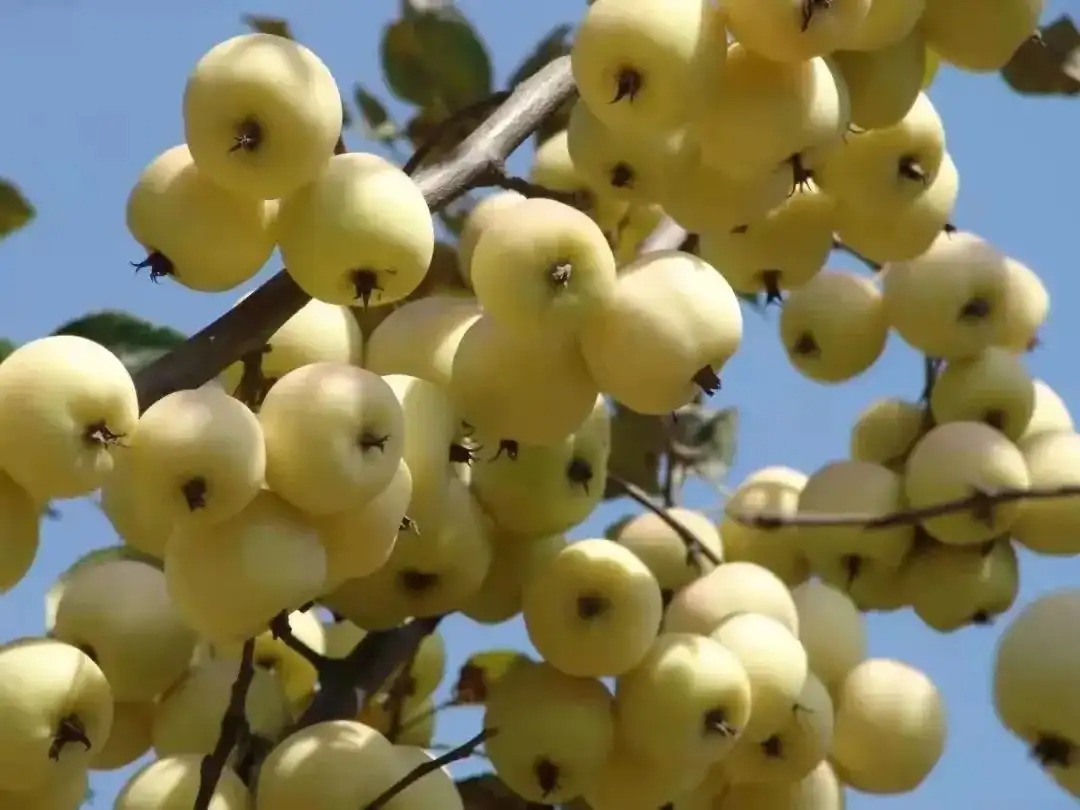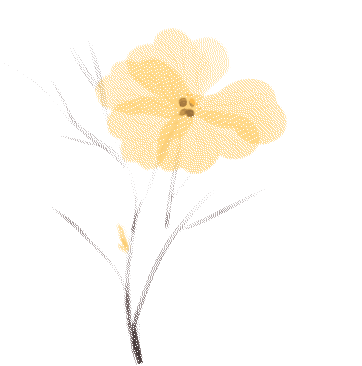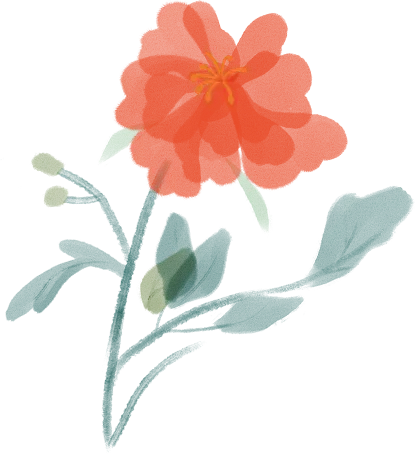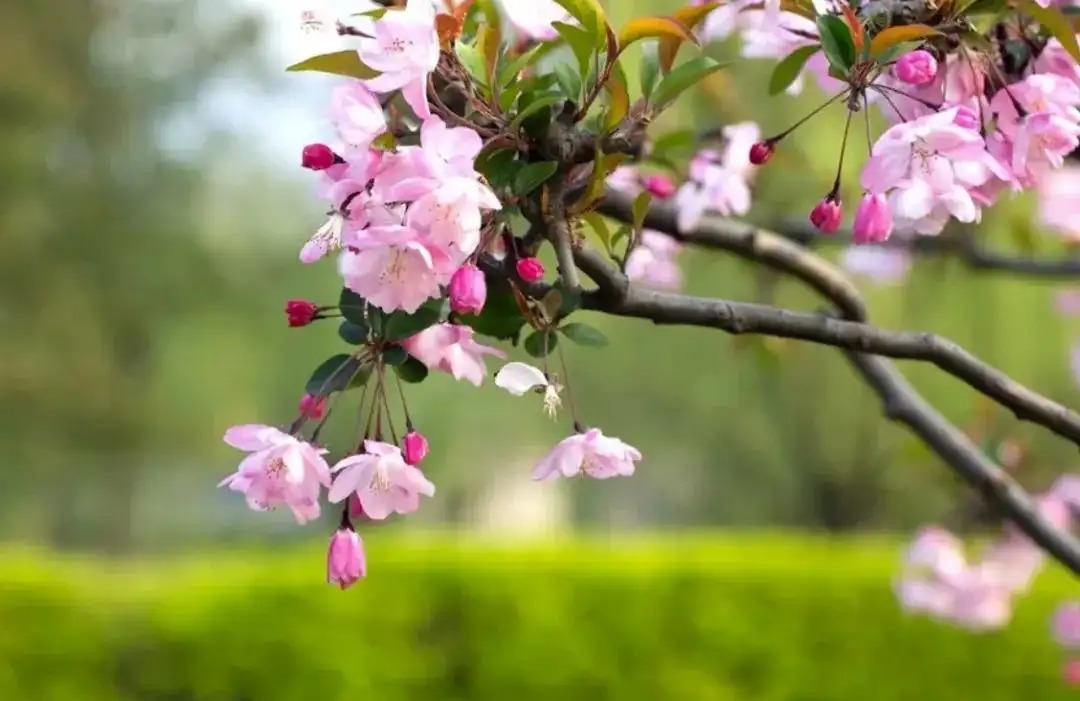The application and development prospects of ornamental fruit trees in northern gardens
China-Fruits
Ornamental fruit trees, also known as landscape fruit trees, are fruit trees with the main purpose of viewing. They have the characteristics of leaves, flowers, fruits, and shapes, a long viewing period, and striking viewing effects. At the same time, they have the characteristics of strong cultivation adaptability and easy management. At present, there are not many studies on ornamental fruit trees as the main plant landscape materials, which are only seen in collection and identification research. Liaoning Fruit Science Research Institute has collected 89 ornamental fruit tree resources so far, and 42 have been identified. With the increasing strategic position of ecological civilization construction, in order to create a healthy and green ecosystem, ornamental fruit trees are widely used in garden design because of their beauty and practicality. The application of ornamental fruit trees makes the tree species structure in the garden landscape more reasonable. In the garden landscape, they have the functions of viewing flowers, leaves, fruits, and shapes. They not only enrich the color and level of the garden landscape, but also produce certain ecological and economic benefits. Based on many years of work experience, the author briefly discusses the application and development prospects of ornamental fruit trees in northern gardens from the following aspects, in order to provide reference for the breeding and cultivation research of ornamental fruit trees.



Common ornamental fruit tree species in northern gardens

Fruit tree resources are rich, with 59 families, 158 genera, more than 670 species, and more than 10,000 varieties. The most species are in Rosaceae, Vitaceae, Rhamnaceae, Moraceae and Sapindaceae. Among these fruit trees, ornamental fruit trees are more suitable for garden plant configuration. There are more than 40 ornamental fruit trees commonly used in northern garden plant configuration. According to the different ornamental parts, they can be divided into flower-viewing, fruit-viewing, leaf-viewing, and shape-viewing fruit trees. Some ornamental fruit trees have two or three ornamental values at the same time.

Flower viewing
The commonly used flowering fruit trees in the north include mountain peach, pink peach, wild apricot, crabapple, crabapple, weeping crabapple, apple (including red flesh apple), and Xanthoceras sorbifolia.

Fruit viewing
The fruits of some fruit trees not only have economic value but also ornamental value. Commonly used ornamental fruit trees in the north include hawthorn, jujube, apple (including red-fleshed apple), pear, Xanthoceras sorbifolia, mulberry, apricot, plum, cherry, etc.

Foliage
Foliage fruit trees are mainly appreciated for the color of their leaves, which are often non-green. They mainly include yellow, red, dark red, dark brown, and yellow-green colors. Foliage fruit trees can also be divided into two types depending on whether the colored leaves appear throughout the entire growing season.
Fruit trees with colorful leaves throughout the growing season
Colorful-leaf ornamental fruit trees are a type of colorful-leaf plants. Colorful-leaf plants refer to plants whose leaves are all or partly non-green throughout the growing season. Colorful-leaf plants are popular because of their brightly colored leaves, long viewing period, easy cultivation and management, and fast landscape creation. Commonly used colorful-leaf ornamental fruit trees in northern gardens include purple-leaf plum, purple-leaf chrysanthemum, royal crabapple, purple-leaf box fruit, red flesh apple, etc., with dark red or dark brown leaves, and variegated ginkgo with yellow and green leaves.
Foliage fruit trees whose colored leaves do not last throughout the growing season
The color of plant leaves is mainly determined by the content and distribution of pigments in the leaves. Chlorophyll is the main pigment in photosynthesis, which makes the leaves green; anthocyanins make the leaves red; carotenoids and flavonoids make the leaves yellow. In autumn, chlorophyll has poor adaptability to temperature. Low temperature accelerates the decomposition of chlorophyll and limits the synthesis of new chlorophyll. At this time, carotenoids are more stable and decompose slowly, making the leaves appear yellow.

Shape-viewing
This type of fruit trees is mainly used to appreciate the tree shape and branch posture, such as fig, pecan, Xanthoceras sorbifolia, ginkgo, weeping ginkgo, hawthorn, mulberry, jujube, etc.

The role of ornamental fruit trees in garden landscape


Ecological benefits
Ornamental fruit trees, like other tree species, have many important functions. They can replenish oxygen, promote water circulation, improve soil, and conserve water resources. Some ornamental fruit trees can also absorb a large amount of dust and harmful gases in the air and reduce noise. Pomegranates have a strong adsorption capacity for sulfur dioxide and lead vapor; cherries have anti-smoke and dust absorption effects; the volatile smell of walnut trees has a bactericidal and insecticidal effect; figs have the effect of purifying the air and preventing noise. In addition, ornamental fruit trees also have unique ecological functions. Their flowers and fruits can attract a large number of insects, birds and other species, which not only enriches the biological circulation system and increases biodiversity, but also helps maintain ecological balance and adjust tree species structure.

Viewing Benefits
Seasonal phase refers to the different sequence changes of leaves, flowers and fruits of garden plants in different seasons due to the influence of environmental factors such as sunlight, temperature and water. Ornamental fruit trees have high ornamental value because of their multiple ornamental parts and rich seasonal changes. The seasonal changes of plants can express the temporal beauty of plant landscapes. When arranging garden plants, a landscape effect of "there are always views and different seasons" can be created. The main methods of plant arrangement include cluster planting, solitary planting, row planting, piece planting, etc. Ornamental fruit trees can produce different ornamental effects by using different arrangement methods.
Cluster Planting
Many ornamental fruit trees are used in cluster planting. In the classic "five-layer greening", they are often located in the sub-tree layer and the large shrub layer. The sub-tree layer - the tree shape and branches are beautiful, occupying the upper space of the line of sight; the large shrub layer - the flowers and leaves are full and colorful, occupying the middle and lower space of the line of sight, and are in the main view position of the line of sight. Therefore, the reasonable use of ornamental fruit trees will make the group of plant configuration more vivid and interesting.
Solitary Plant
Ornamental fruit trees for solitary planting are mainly those with graceful tree shapes. The twigs and young leaves of red-fleshed apples are red to purple-red, the flower color is bright purple-red, and the fruit is attractive purple-red from young fruit to mature fruit. The fruit surface is gorgeous, the fruit viewing period is long, and the fruit does not fall in winter (can last until February-March of the following year). It is a rare tree species for viewing leaves, flowers, and fruits. It has high ornamental value for solitary planting. Hawthorn is a fruit tree that combines viewing leaves, fruits, and shapes. It has large leaves with deep fissures, beautiful leaf shape, and deep red fruits. Clusters of red fruits are dotted between the leaves, which are smart and lively. It is also very ornamental for solitary planting.
Row Plant
In landscape design, the row planting technique is often used for street tree planting. The trees are arranged in a linear pattern, and the neat boundary sense plays a role in guiding the sight. Ornamental fruit trees that can be used for street tree planting include ginkgo, mountain peach, purple-leafed chrysanthemum, etc. Ginkgo has a straight trunk, which makes it easier to show a neat, unified, balanced and symmetrical effect when planted in a row; when mountain peach is used as a street tree, a tree with a relatively straight trunk and a fixed trunk of more than 2.5m should be selected. Mountain peach trees with low branching points and too open tree shapes are not suitable for street tree planting, as they will block the sight of pedestrians.
Planting
Many tourist attractions have large areas of flower fields, which is a garden design technique that uses large areas of ornamental fruit trees. This large area of "color blocks" can bring people a strong visual impact. In the Peach Blossom Valley of the Apricot Valley and Meilin Valley in Harqin Banner, Chifeng City, Inner Mongolia Autonomous Region, large areas of wild apricots and pink peach blossoms bloom one after another from late March to early April every year. It is very spectacular from a distance, attracting many tourists to come and watch and take pictures.

Economic Benefits
In addition to ecological and ornamental benefits, ornamental fruit trees can also produce good economic benefits, which are mainly reflected in the following two aspects.
Driving the development of tourism
In the process of promoting the construction of ecological civilization, agricultural ecological tourist parks have emerged around cities. Most of the tourist parks adopt a three-dimensional management model that integrates green sightseeing, tourism and leisure vacations, and fruit picking. This has greatly promoted the improvement and development of the local tourism market and achieved the unity of economic and ecological benefits. The combination of the two has brought a virtuous circle for rural development, thereby driving the development of local tourism.
Medicinal value of seeds and fruits
Some ornamental fruit trees have high medicinal value because of their seeds and fruits. They can beautify the environment and bring certain economic benefits. Amygdalin (vitamin B17) is commonly found in the seeds of peach, plum, apricot and other fruits, especially in wild apricot seeds, with the highest content, accounting for 2.0%~3.0%. Harvesting seeds and fruits can bring considerable economic income to operators.

The current situation and cultivation prospects of ornamental fruit trees

Ornamental fruit trees combine ornamental value and economic value, effectively increasing the sustainability of garden landscapes. With the improvement of biotechnology and in-depth research on the ornamental fruit tree market by scientific researchers, more and more colorful ornamental fruit trees have been selected and cultivated, such as purple-leaf dwarf cherry, red-fleshed apple, purple-leaf box fruit, variegated ginkgo, purple-leaf chrysanthemum, etc. The cultivation of these colorful ornamental fruit trees has greatly enriched the varieties of fruit trees, and has high ornamental value, and has been widely used in the configuration of garden plants. If the use of ornamental fruit trees enriches the ornamental and cultural nature of garden landscapes, then the emergence of colorful ornamental fruit trees has further broadened people's horizons. It can be predicted that the demand for colorful ornamental fruit trees will increase in the future. According to incomplete statistics, the share of green seedlings in greening projects is 97%, and colorful seedlings only account for 3%, while in developed countries, green seedlings account for 65% and colorful seedlings account for 35%. Some experts predict that colorful seedlings should account for 15% to 20% of greening seedlings. As people's demand for a better life grows, the development of colorful-leaf seedlings has huge market potential, and colorful-leaf ornamental fruit trees will lead the development of the ornamental fruit tree market.
At present, the use of colorful vegetation is mainly based on foreign introduction, and the development and utilization of local colorful vegetation is relatively scarce, which seriously restricts the sustainable development of related industries. With the development of modern molecular biology technology, molecular breeding technologies such as gene editing technology, transgenic technology, and molecular markers have the advantages of short cycle, high efficiency, and high precision of directional breeding, and have become an important means of modern fruit tree improvement breeding research. In addition, through new technologies such as bud mutation breeding and mutagenesis breeding, uniform offspring can be produced through asexual reproduction. These biotechnologies have greatly improved breeding efficiency and have been applied to the breeding of colorful ornamental fruit trees. For example, purple-leaf dwarf cherry and purple-leaf plum are excellent tree species bred through bud mutation. It is imperative to independently select and breed varieties with market competitiveness. How to cultivate colorful ornamental fruit trees that are easy to survive, have strong resistance to adversity, have bright flower and leaf colors, excellent fruit quality, and a long ornamental period is a topic worthy of further in-depth research by scientific researchers. It also requires seedling dealers and nurseries to strengthen cooperation with scientific research institutions, timely update the cultivation of newly developed superior varieties, grasp market conditions, and cultivate new and superior varieties in a targeted manner. Multiple departments should work together to strengthen the introduction and cultivation of colorful ornamental fruit trees with strong adaptability and good performance, and accelerate the domestication of excellent tree species.

Statement:
Disclaimer: This article is excerpted from "The Application and Development Prospects of Ornamental Fruit Trees in Northern Gardens" (Zhang Yaguang, Zhang Wei, Du Mei'e, Zhang Liyi) in the 11th issue of "Fruit Trees" in 2022. Personal sharing is welcome. If any other media or website needs to reprint, the source must be indicated before the text: Fruit Trees.